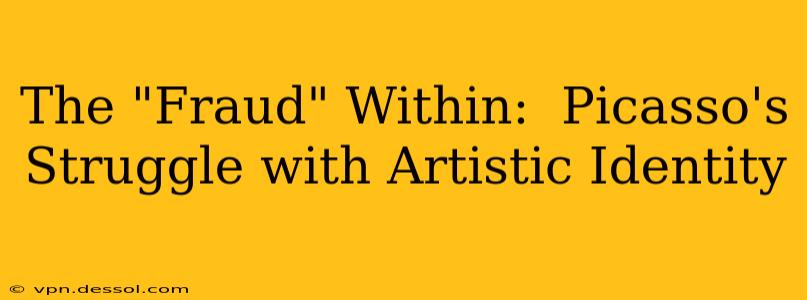Pablo Picasso, a name synonymous with artistic genius and revolutionary innovation, wasn't immune to the gnawing anxieties of self-doubt. Beneath the surface of his prolific career and groundbreaking styles lay a persistent internal struggle, a feeling he himself described as a kind of "fraud." This essay delves into Picasso's complex relationship with his artistic identity, exploring the sources of his insecurities and how they ultimately shaped his extraordinary body of work.
What Made Picasso Feel Like a Fraud?
Picasso's feeling of being a "fraud" wasn't rooted in a lack of talent or achievement. Instead, it stemmed from his relentless pursuit of artistic evolution. His rapid stylistic shifts, from the Blue Period to Cubism and beyond, could be interpreted as a continuous search for authentic self-expression, a quest that never fully satisfied him. The pressure to constantly innovate, to surpass his previous achievements, created a self-imposed burden that fueled his internal conflict. He was never content to rest on his laurels, always pushing the boundaries of artistic expression, a process that inevitably led to moments of intense self-criticism and feelings of inadequacy. This relentless drive, while producing a breathtaking range of masterpieces, also contributed to his profound sense of insecurity.
Did Picasso Ever Overcome His Feelings of Inadequacy?
The simple answer is no. Picasso's struggle with self-doubt seems to have been a lifelong companion. However, it's crucial to understand that this internal conflict wasn't necessarily a negative force. His insecurity acted as a catalyst, pushing him to relentlessly experiment and explore. The very act of constantly reinventing himself, of grappling with his artistic identity, became an integral part of his creative process. His feeling of being a "fraud" wasn't a sign of weakness, but rather a testament to his unwavering commitment to pushing the boundaries of art and his own capabilities. The tension between his self-criticism and his ambition fueled his extraordinary output.
How Did Picasso's Insecurities Influence His Art?
Picasso's insecurities profoundly influenced his artistic style and output. His rapid stylistic shifts can be seen as attempts to escape the confines of his previous achievements, to constantly redefine his artistic identity. The relentless experimentation, the constant striving for something "more," is evident in the diverse and often jarring transitions throughout his career. His Cubist phase, for instance, can be interpreted as a radical attempt to break free from traditional representation and forge a new language of artistic expression. This constant reinvention was a direct response to his inner turmoil, a manifestation of his struggle to reconcile his self-perception with his phenomenal talent.
Was Picasso's Artistic Genius a Result of His Insecurities?
While we cannot definitively say that Picasso's insecurities caused his genius, it's undeniable that they played a significant role in shaping his artistic trajectory. His self-doubt fueled his relentless pursuit of innovation, driving him to constantly challenge himself and push the boundaries of artistic expression. His insecurities, paradoxically, became a source of creative energy, propelling him to achieve unprecedented levels of artistic innovation. The internal conflict he experienced became the very engine of his genius.
What Can We Learn from Picasso's Struggle with Artistic Identity?
Picasso's experience offers valuable insights for artists and creatives of all levels. It reminds us that self-doubt is not necessarily a sign of failure but can be a powerful catalyst for growth and innovation. His relentless pursuit of self-expression, despite his internal conflicts, serves as an inspiration to embrace our own vulnerabilities and use them to fuel our creativity. His journey highlights the importance of constant experimentation and the courage to push beyond our comfort zones, even when faced with feelings of inadequacy. The legacy of Picasso is not just his art, but also the profound understanding of the creative process that his personal struggles reveal. His story encourages us to embrace the "fraud" within, recognizing it as a potential source of unparalleled artistic achievement.

